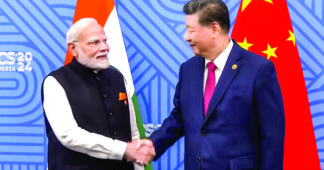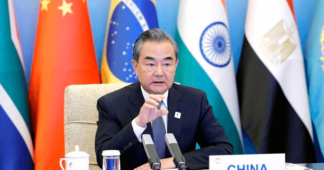by Keji Mao*
Apr 10,2025
Featured Image: Mahalanobis and Zhou Enlai at the Indian Statistical Institute, Calcutta, December 9, 1956. Photo: Author.
In an increasingly uncertain world, India’s decision to ‘learn’ from China’s agricultural successes serves as a potent reminder.
In the winter of 1955, the prime minister’s residence in New Delhi welcomed a distinguished Chinese scholar. For a fortnight, he lived under the same roof as Jawaharlal Nehru and Indira Gandhi – sharing breakfast and dinner each day, and engaging in long, meandering walks and conversations afterward. The camaraderie was so profound and productive that Nehru even highlighted the scholar’s incisive insights in his fortnightly letters to the chief ministers of India’s states.
What, one might ask, could have prompted the Indian prime minister to extend such above-and-beyond hospitality to a Chinese scholar? The answer lay in the identity of the guest – none other than the renowned Chinese economist Chen Hansheng. Nehru’s insistence on hosting Chen and engaging in such repeated, in-depth discussions stemmed from a keen desire to absorb the latest lessons in economic development emanating from China.
The slogan “Hindi-Chini bhai–bhai (Indians and Chinese are brothers),” often evokes images of the close coordination during the Bandung Conference and the joint advocacy for the Five Principles of Peaceful Coexistence. Yet, few recall that over 70 years ago, India was swept up in a far-reaching wave of enthusiasm for “learning from China” in the realm of economic development.
In November 1954, on the eve of India’s implementation of the Second Five-Year Plan, Nehru learned of the groundbreaking achievements of China’s First Five-Year Plan. His reaction was twofold: a genuine elation for the remarkable progress of a fellow Asian giant, as well as an acute sense of competitive urgency. “These Western countries have had 150 years or more of industrial growth…We are not going to have 100 years in order to make good,” he remarked. “Our problem, therefore, are essentially similar to those of other underdeveloped countries in Asia. It is for this reason that I was particularly interested in what was happening in China and I said that the most exciting countries for me today were India and China.”
Privately, Nehru also revealed his determination to prevail in this developmental contest with China:
“We differ, of course, in our political and economic structure, yet the problems we face are essential the same. The future will show which country and which structure of Government yields greater results in every way.”
For India’s top officials, China represented the only nation that shared many of India’s own characteristics. Both countries had been victims of imperialist and colonial exploitation; both grappled with acute human-land resource tensions, widespread unemployment, and stagnating productivity; and both faced the daunting challenge of amassing surplus capital to fuel rapid industrialisation. Most importantly, both aspired to a similar political ideal: the pursuit of economic equality and social justice.
For developing nations, the greatest challenge in achieving rapid industrialisation lay in securing sustainable financial backing, cultivating a sufficiently large market, and keeping inflation in check – all of which required a deeper exploration of agricultural potential. India’s most pressing obstacle at the time was a “resource constraint”: while the thrust for rapid industrial growth demanded an unprecedented increase in agricultural output, the latter could not meet the soaring industrial needs without diverting critical investment away from industrial development.
At this juncture, the Chinese model emerged as a beacon of hope. It was Chen, who revealed to Nehru that after completing its socialist transformation of agriculture, China had dramatically boosted the efficiency of human labour, animal power, agricultural inputs – and even the use of manure. This revolutionary drive had propelled China’s agricultural output to surge by as much as 35 to 40 percent over five years, all without a noticeable increase in resource input. Such results offered India a promising solution to its most intractable resource dilemma.
Throughout the mid-1950s, dozens of Indian officials from the Congress party, both houses of parliament, the ministries of food and agriculture, and the National Planning Commission undertook visits to China. They sought counsel from China’s top governmental organs, including the Communist Party’s Central Committee, the State Council, and the National Planning Commission. Both Nehru and India’s economic helmsman, P.C. Mahalanobis, were so impressed by China’s socialist construction achievements that they found themselves deeply moved.
Even at a time when Sino-Indian relations were strained, Mahalanobis conceded in interviews that “China provided a better model of development for India than the advanced western countries.” China’s experience – demonstrating that even subsistence agriculture, when reorganised through land reform and rural reorganisation, could support a leap in industrial development – was nothing short of remarkable.
Nehru himself, after returning from China, spoke frequently of the rapid growth of industrial and agricultural cooperatives there. His admiration and curiosity were such that he immediately ordered the formation of several study delegations to China to probe the causes behind its agricultural boom. In 1956, the National Planning Commission dispatched an “Agricultural Cooperative Study Group” to China with a mandate to investigate, down to the details, the strategies behind China’s cooperative model – a mission that would later evolve into the well-known Patil Committee. Concurrently, the Ministry of Food and Agriculture sent a separate “Agricultural Planning and Technology Study Group” to examine the “secret” behind China’s dramatic productivity gains.
Both delegations arrived in China in mid-July 1956, spending two months traversing eight provinces and visiting at least twenty rural cooperatives. The ministry group even engaged in in-depth discussions with experts from China’s Ministry of Agriculture and the National Planning Commission. V. T. Krishnamachari, then vice-chairman of India’s National Planning Commission, discovered that China’s rural reforms had increased agricultural output by 15 to 30% in just two to three years. Sweeping land reforms – redistributing land equally – had spurred farmers to embrace collective projects with renewed zeal, from reclaiming wasteland to constructing dams and digging wells. In one province, within a single season, 300,000 wells and 100,000 dams were built, effectively doubling the irrigated area. Even in the task of collecting farmyard manure – a laborious, unglamorous chore – the Chinese mass exhibited extraordinary enthusiasm, amassing 70% of the required quantity even before the next fertilisation season.
The ministry group reached a similar conclusion: “China’s experience shows that given certain conditions, it is possible through cooperatives to organise rural manpower resources so as to ensure a higher level of employment for all members of the community and not merely those who happen to have fair-sized agriculture holdings. This is significant for our future development.”
Inspired by China’s achievements, Nehru became convinced that land reform could well improve the efficiency of existing resources, enabling increased agricultural output without extra investment. He even used China’s example to scold the agriculture ministry for its complacency in assuming that only additional resource inputs could boost production. In one of his letters to the chief ministers, he says:
“[China] where millions of cooperative farms have sprung up, how then, are we to increase this [agricultural] production? We know for a fact that some other countries have rapidly increase their food production in the last few years without any tremendous use of fertilizers. How has China done it? China’s resources in this respect are not bigger than ours. China is at the same time laying far greater stress on industrial development and heavy industry than we are. Yet, they are succeeding in increasing their agricultural production at a faster pace than we are. Surly, it should not be beyond our powers to do something that China can do.”
Inspired by this Chinese experience, Nehru in 1958 launched what was perhaps the most progressive and historically significant land reform in India’s history – the Nagpur Resolution. The resolution promised to complete comprehensive land reforms, including imposing ceilings on land holdings, by the end of 1959, and it vigorously promoted the movement toward rural cooperatives: surplus rural land was to be collectively owned by the village community rather than held by individuals, and cooperatives composed of landless labourers would manage its use.
Although the ambitions of the Nagpur Resolution – and the broader big-push industrialisation strategy that India wholeheartedly embraced – ultimately fell short due to a host of internal and external challenges, the spirit of mutual assistance, reciprocal learning, and cooperative exchange between China and India, born out of that fervour for “learning from China,” continues to resonate powerfully today.
In an increasingly uncertain world, revisiting India’s “learning from China” episode serves as a potent reminder: China and India remain the only two nations in the world with populations exceeding one billion, and as each other’s largest neighbours, they are uniquely positioned to rekindle that cooperative spirit and become true partners in development.
*Keji Mao is an analyst at the International Cooperation Center, the founder of the South Asia Research Brief, and visiting fellow at the Harvard-Yenching Institute.
We remind our readers that publication of articles on our site does not mean that we agree with what is written. Our policy is to publish anything which we consider of interest, so as to assist our readers in forming their opinions. Sometimes we even publish articles with which we totally disagree, since we believe it is important for our readers to be informed on as wide a spectrum of views as possible.











